About Koalas - this is our technical in depth page!
About Koalas
Koalas (Phascolarctos cinereus) are arboreal (tree-dwelling) marsupials that are endemic to Australia. They have a broad, although patchy, distribution within the eucalypt forests and woodlands of eastern Australia, extending from North Queensland to South Australia.
The koala (combined populations of Queensland, New South Wales and the Australian Capital Territory) was listed as endangered on 12 February 2022 under the Commonwealth Environmental Protection and Biodiversity Conservation (EPBC) Act 1999. Koala populations are threatened by habitat loss, vehicle collisions, dog attacks, climate change and disease [1, 2, 3, 4].
The koala is a marsupial which means they carry their young in a pouch. Well-known marsupials include kangaroos, wallabies, possums and wombats. Other marsupials include bandicoots, bilby, bettongs, quolls and quokkas. The closest relative of the koala is the wombat.
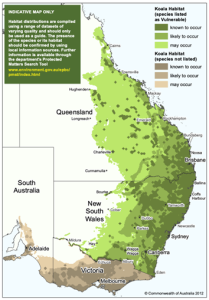
Unique Adaptations
Koalas have five (5) digits on each front paw, two (2) of which are opposed to the others, this helps them to hold firmly onto the branches and to grip their food. The second and third digits on their hind paws are fused together to form a grooming claw.
Koalas have thick, woolly fur which protects them from the extremes of both high and low temperatures, and which also acts like a ‘raincoat’ to repel moisture when it rains. The fur varies in colour from light grey to chocolate brown.
The dorsal (back) fur of the koala is the most insulated of any marsupial. The ventral (belly) surface has half the density of the dorsal surface and is more reflective of solar radiation. In cold weather, koalas will curl into a ball with the dorsal fur providing effective insulation from the cold and rain. In warmer months, they will often sit sprawled out with their ventral surface exposed to the sun, which has a cooling effect [5].
Koalas from the northern populations are typically smaller and lighter in colour than their larger, darker and thicker furred counterparts further south. This is thought to be an adaptation to keep them warm in the colder southern winters [6].
TABLE 1: Size of Male and Female Northern and Southern Koalas [6]
Gender | Length/ Weight | Southern Koalas | Northern Koalas |
Male | Length | 75-82cm (Average 78.2cm) | 67.4-73.6cm (Average: 70.5cm) |
Weight | 9.5 – 14.9 kg (Average 12 Kg) | 4.2-9.1kg (Average: 6.5kg) | |
Female | Length | 68-73cm (Average: 71.6cm) | 64.8-72.3cm (Average: 68.7cm) |
Weight | 7-11kg (Average: 8.5kg) | 4.1-7.3kg (Average: 5.1kg) |
Koalas use a range of sounds to communicate with one another over large distances. Their large ears provide a keen sense of hearing, which is necessary for their socialisation with other koalas, as they can live in populations where each Koala lives large distances apart. Males save fighting energy by bellowing their dominance, and they also bellow to allow other animals to accurately locate their position. Koalas also communicate by marking their trees with their scent.
Koalas rely on their highly developed sense of smell to differentiate levels of toxins, nutrients and moisture in eucalyptus leaves. They also need to smell the scent warnings put on trees by other koalas.
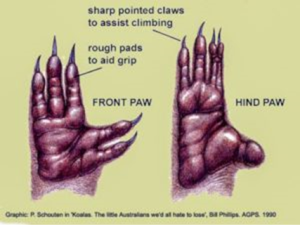
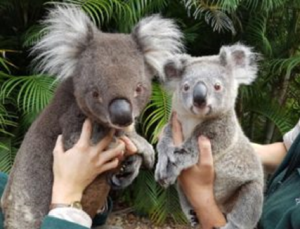
Diet
Koalas are specialist folivores and feed on a variety of eucalypt leaves and a few other related tree species, including Lophostemon, Melaleuca and Corymbia species [9, 10]. They consume around 500 grams of leaves each day, (approximately the size of a small lettuce). Koalas have strong regional preferences for certain eucalypt species. In a particular district, koalas may feed almost entirely on one or two species. Other tree species are also used as a food source or provide important habitat values, such as provide good shade and shelter. These trees also provide other benefits such as erosion protection, food sources and nesting sites for other wildlife species including mammals and birds [11].
The following trees are recognised as important koala food trees in South East Queensland [11, 12]:
- Blue Gum (Eucalyptus tereticornis)
- Tallowwood (Eucalyptus microcorys)
- Grey Gum (Eucalyptus propoinqua)
- Red stringybark (Eucalyptus resinifera)
- Swamp mahogany (Eucalyptus robusta)
Other food and habitat species include:
- Scribbly Gum (Eucalyptus racemosa)
- Queensland White Stringybark (Eucalyptus tintaliae)
- Queensland Grey Ironbark (Eucalyptus siderophloia)
- Broad-leaved Ironbark (Eucalyptus fibrosa)
- Gum-top Box (Eucalyptus moluccana)
- Narrow-leafed Ironbark (Eucalyptus crebra)
- Narrow-leafed Redgum (Eucalyptus seeana)
- Mountain Grey Gum (Eucalyptus major)
- Flooded gum (Eucalyptus grandis)
- Swamp mahogany (Eucalyptus robusta)
- Broad-leaved White Mahogany (Eucalyptus carnea)
- Spotted Gum (Corymbia citriodora)
- Pink Bloodwood (Corymbia intermedia)
- Broad-leaved Paperbark (Melaleuca quinquenervia)
- Brush Box (Lophostemon confertus)
For information on planting koala trees please click here.
Eucalypts leaves have low nutritional value and are high in indigestible or toxic materials (cellulose, lignin, plant secondary metabolites, phenolic compounds and terpenes) which most animals cannot eat [13, 14, 15]. This presents a challenge for koalas to choose leaves with sufficient nutritional values and tolerable levels of toxins. Koalas are able to break down the toxic materials using a specialised digestive system. First, the leaves are ground into a paste by the koala’s heavily ridged molars, allowing any nutrients to be absorbed in the stomach. Toxins in the leaves are isolated by the liver and excreted as waste in their urine and faeces. The residue is then broken down by specialised bacteria in the caecum that branches off the large intestine before any remaining nutrients are digested [16]. Koala joeys are not born with this specialised bacteria in their system, instead they need to acquire it from their mother. The mother passes on this bacteria by excreting a soft faecal substance called ‘pap’, which the young ingests instinctively, providing it with the bacteria it needs to eat the leaves in adult life [16].
Koalas are notoriously selective feeders, and are often observed sniffing leaves before tasting them [17]. Their leaf ‘pickiness’ has been found to be related to the complexity and concentration of toxic materials (such as plant secondary metabolites) in the eucalyptus leaves [18]. Koalas have been found to make food choices both to target higher concentrations of nutrients and moisture and to avoid plant secondary metabolites [19, 20].
Soil type and seasons have a major impact on whether leaf in a certain area is palatable, so whilst koalas may favour a species of eucalypt from one area, they may not eat it if it comes from a different area. There are also some species of eucalypt that koalas favour only in a specific season [12].
It is a myth that koalas get drunk or high on eucalyptus leaves. It requires a lot of energy to digest their toxic, fibrous, low-nutrition diet and sleeping is the best way to conserve energy. Therefore, koalas don’t move a lot and generally sleep up to 20 hours per day.
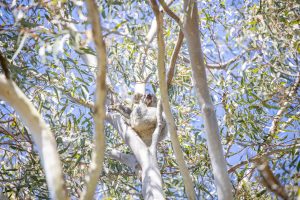
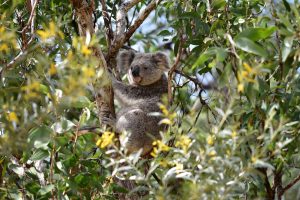
Reproduction and Development
A koala joey is born after a 35-day gestation. The jelly-bean sized joey makes its way through its mother’s fur from the birth canal to the pouch, where it immediately attaches itself to one of the mother’s 2 teats and begins drinking milk. The joey will remain in the pouch until it is approximately 5.5 to 6 months of age. At this point the joey will become more adventurous and start to climb out of the pouch and onto its mother’s belly, next they will travel on their mother’s back. Complete independence from the mother occurs between 12 to 18 months of age. Between approximately 20-36 months of age sub-adults generally move away from their maternal home range to establish their own territory. Sexual maturity is from approximately 2 years onwards [12].
The koala breeding season, in South-east Queensland, extends from August through to January, with most young born over the summer months [12]. This is a time of increased movement for Koalas, with sound levels increasing as males bellow more frequently.
As a young koala becomes sexually mature, it must disperse away from its mother’s home range and find a territory of its own. Dispersal is usually undertaken by sub-adult koalas in the pre-mating and early mating period of the breeding season from June to December [21]. During this dispersal time, juveniles may travel a great distance and are at a much higher risk of being attacked by a dog, hit by a car, or other misadventure. High mortality rates are reported for koalas in urban and peri-urban areas during this period due to domestic dog attacks and vehicle collisions [3, 22]. Most dispersing individuals are approximately 20–36 months of age [22].
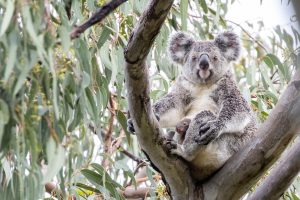
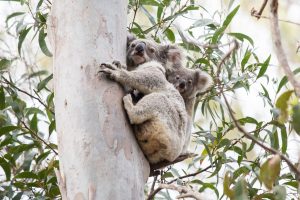
Population Dynamics
Koalas are generally asocial animals, and bonding exists only between mothers and dependent joeys. They live in relatively well-defined home ranges, which border or partially overlap adjacent home ranges of other individuals [12]. The home range of an alpha male will overlap with females that live in the area. Non-dominant or sub-adult males home ranges may slightly overlap with a section of the alpha males territory. Koala home range sizes are variable and are influenced by habitat quality, season, koala density and sex [23]. Females usually have smaller home ranges than males.
Adult males communicate with loud bellows that intimidate rivals and attract mates. Males mark their presence with secretions from scent glands located on their chests. Males will seek out a mate and fight with rival males to establish their dominance [16]. There will be some fur flying when two males are fighting over a territory or a female.
Threats
Koalas face a range of threats, including loss and fragmentation of habitat, urbanisation (including associated threats of domestic dog attacks and vehicle collisions), climate change and disease.
Koalas move across the ground to forage, find mates, or disperse, but this is also when they are at the most risk from threats such as dog attacks and vehicle collisions. Therefore, habitat loss and fragmentation may have the combined effect of not only reducing the amount of habitat, but also increasing the amount of time koalas must spend moving on the ground at risk from a range of threats. There is growing evidence that increased stress from these factors is impacting on their long-term health and wellbeing and ultimately leading to disease.
There are four (4) main threats to koala survival in South East Queensland:
- habitat loss;
- vehicle strikes;
- disease; and
- dog attacks.
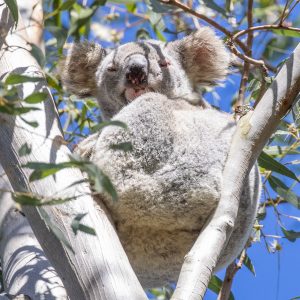
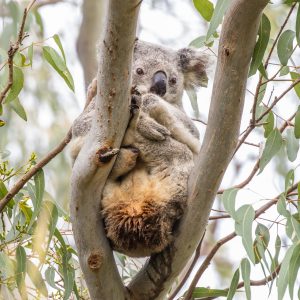
Habitat Loss
Koalas face a range of threats, including loss and fragmentation of habitat, urbanization (including associated threats of domestic dog attacks and vehicle collisions), climate change and disease.
Koalas move across the ground to forage, find mates, or disperse [24], but this is also when they are risk of mortality from threats such as dog attacks and vehicle collisions. Therefore, habitat loss and fragmentation may have the combined effect of not only reducing the amount of habitat, but also increasing the amount of time koalas must spend moving on the ground at risk from a range of threats [21]. There is growing evidence that increased stress from these factors is impacting on their long-term health and wellbeing and ultimately leading to disease.
As outlined in both the South East Queensland koala population modeling study [21] and South East Queensland Koala Conservation Strategy (2020–2025) [25], there are four (4) main threats to koala survival in South East Queensland:
- habitat loss;
- vehicle strikes;
- disease; and
- dog attacks.
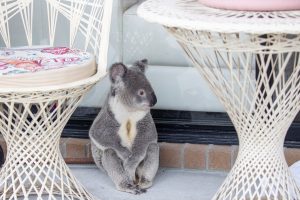
Disease
Koala populations are currently in rapid decline across Australia, with infectious diseases being a contributing cause. Koalas are prone to a number of diseases. Chlamydia and the Koala Retrovirus (KoRV) are the most threatening to the survival of the koala. These diseases are exacerbated by a number of factors including chronic stress, poor nutrition and immunosuppressive diseases.
Chlamydia
Chlamydia is a serious, debilitating and potentially fatal disease caused by two different strains of the bacterium Chlamydia (Chlamydia pecorum and Chlamydia pnemoniae). It commonly causes ocular and urogenital diseases such as conjunctivitis, reproductive tract disease, and urinary tract infections (cystitis). Less common manifestations include respiratory infections (pneumonia). Chlamydia can concurrently cause both ocular and urogenital disease in the same koala. Chlamydia is considered a sexually transmitted disease, however congenital transmission has also been shown.
Chlamydia conjunctivitis is where the eyes (both or just one) are inflamed and crusted. In severe cases, conjunctivitis can cause blindness, however most cases are treatable with antibiotics.
Chlamydial cystitis is a painful disease where the bladder wall is thickened and the koala is constantly dripping urine.
Females have a high chance of developing reproductive cysts, which can become larger than oranges and cause infertility. Infertility from Chlamydia is a contributing factor to the current decline in koala numbers.
Koalas suffering from Chlamydia have a good chance of recovery if they are treated in the early stages of the disease. Researchers are working on developing a vaccination program for koalas and the initial results are promising.
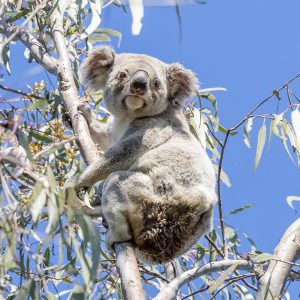
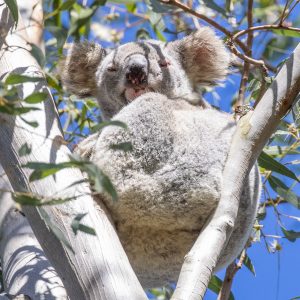
Koala Retrovirus (KoRV)
KoRV infection exhibits differences within and between populations; these include endogenous and exogenous KoRV subtypes, which can be associated with variable immune responses [35]. KoRV infection in koalas has been linked to the development of cancers like lymphoma and increased susceptibility to chlamydial disease development [36, 37, 38, 39]. Koala retrovirus (KoRV) infects the majority of Australia’s koalas and thus poses a threat to the continued survival of this species
Resources
- Dique, D. S., J. Thompson, H. J. Preece, G. C. Penfold, D. L. de Villiers, and R. S. Leslie. 2003. Koala mortality on roads in south-east Queensland: the koala speed-zone trial. Wildlife Research 30:419-426.
- Lunney, D., S. Gresser, L. E. O’Neil, A. Matthews, and J. R. Rhodes. 2007. The impact of fire and dogs on koalas at Port Stephens, New South Wales, using population viability analysis. Pacific Conservation Biology 13:189-201.
- Rhodes, J. R., C. F. Ng, D. L. de Villiers, H. J. Preece, C. A. McAlpine, and H. P. Possingham. 2011. Using integrated population modelling to quantify the implications of multiple threatening processes for a rapidly declining population. Biological Conservation 144:1081-1088.
- Seabrook, L., C. McAlpine, G. Baxter, J. Rhodes, A. Bradley, and D. Lunney. 2011. Drought-driven change in wildlife distribution and numbers: a case study of koalas in south west Queensland. Wildlife Research 38:509-524.
- Wildcare (2018). https://wildcare.org.au/species-information/koalas/
- Australian Koala Foundation (2019). https://www.savethekoala.com/about-koalas/physical-characteristics-koala
- Phillips 1990. Koalas. The little Australians we’d all hate to lose. AGPS
- Australia Zoo (2017). Australia Zoo Facebook page May 31st 2017
- Melzer, A., and W. Houston. 2001. An overview of the understanding of koala ecology: how much more do we need to know? Pages 6–45 in K. Lyons, A. Melzer, F. Carrick, and D. Lamb, editors. The Research and Management of Non-urban Koala Populations. Koala Research Centre of Central Queensland, Central Queensland University, Rockhampton
- Office of Environment and Heritage (OEH) (2018). Koala habitat and feed trees. NSW Government
- Department of Environment and Heritage Protection (DEHP). Living with Wildlife – Koalas. QLD Government
- Wildcare (2018). https://wildcare.org.au/species-information/koalas
- Foley, W. J. & Moore, B. D. (2005) Plant secondary metabolites and vertebrate herbivores–from physiological regulation to ecosystem function. Curr. Opin. Plant Biol. 8, 430–435
- Eschler, B. M., Pass, D. M., Willis, R. & Foley, W. J. (2000). Distribution of foliar formylated phloroglucinol derivatives amongst Eucalyptus species. Biochem. Syst. Ecol. 28, 813–824
- Pass, G. J., McLean, S., Stupans, I. & Davies, N. (2001). Microsomal metabolism of the terpene 1,8-cineole in the common brushtail possum (Trichosurus vulpecula), koala (Phascolarctos cinereus), rat and human. Xenobiotica 31, 205–221
- Queensland Government (2017). Koala facts. Department of Environment and Science. https://environment.des.qld.gov.au/wildlife/koalas/koala-ecology.html#diet
- Kratzing, J. E. The anatomy and histology of the nasal cavity of the koala (Phascolarctos cinereus). J. Anat. 138, 55–65 (1984)
- Moore, B. D., Foley, W. J., Wallis, I. R., Cowling, A. & Handasyde, K. A. Eucalyptus foliar chemistry explains selective feeding by koalas. Biol. Lett. 1, 64–67 (2005)
- Villalba, J. J., Provenza, F. D. & Bryant, J. Consequences of the interaction between nutrients and plant secondary metabolites on herbivore selectivity: benefits or detriments for plants? Oikos 97, 282–292 (2002)
- Johnson, Rebecca N, O’Meally, Denis, Chen, Zhillang, Etherington, Graham J, Ho, Simon Y W, Nash, Will J, Grueber, Catherine E, Cheng, Yuanyuan, Whittington, Camilla M, Dennison, Siobhan, Peel, Eemma, Haerty, Wilfried, O’Neill, Rachel J, Colgan, Don, Russell, Tonia L, Alquezar-Planas, David E, Attenbrow, Val, Bragg, Jason G, Brandies, Parice A, Chong, Amanda Yoon-Yee, Deakin, Janine E, Di Palma, Federica, Duda, Zachary, Eldridge, Mark D B, Ewart, Kyle M, Hogg, Carolyn J, Frankham, Greta J, Georges, Arthur, Gillett, Amber K, Govendir, Merran, Greenwood, Alex D, Hayakawa, Takashi, Helgen, Kristofer M, Hobbs, Matthew, Holleley, Clare E, Heider, Thomas N, Jones, Elizabeth A, King, Andrew, Madden, Danielle, Graves, Jennifer A Marshall, Morris, Katrina M, Neaves, Linda E, Patel, Hardip R, Polkinghorne, A, Renfree, Marilyn B, Robin, Charles, Salinas, Ryan, Tsangaras, Kyriakos, Waters, Paul D, Waters, Shafagh A, Wright, Belinda, Wilkins, Marc R, Timms, Peter, Belov, Katherine (2018). Adaptation and conservation insights from the koala genome. Nature Publishing Group 2018
- Rhodes, J. R., Beyer, H. L., Preece, H.J. and McAlpine, C.A. 2015. South East Queensland Koala Population Modelling Study. UniQuest, Brisbane, Australia
- Dique, D. S., J. Thompson, H. J. Preece, D. L. de Villiers, and F. N. Carrick. 2003. Dispersal patterns in a regional koala population in south-east Queensland. Wildlife Research 30:281-290
- Department of Agriculture, Water and the Environment (2022). Conservation advice for Phascolarctos cinereus (koala), Canberra.
- Martin, R. & Handasyde, K. A. (1999) The Koala: Natural History, Conservation and Management. (UNSW Press: Sydney, New South Wales, Australia)
- Queensland Department of Science (DES) (2020). South East Queensland Koala Conservation Strategy (2020–2025). https://environment.des.qld.gov.au/__data/assets/pdf_file/0016/211732/seq-koala-conservation-strategy-2020-2025.pdf
- Redland City Council. https://www.redland.qld.gov.au/info/20301/koala_conservation/1042/threats_to_koalas
- S. G. Kearney et al., Conserv. Sci. Pract. 4, e617 (2022).
- J. R. Dargan et al., Anim. Conserv. 22, 543 (2019).
- D. Lunney, A. Matthews, C. Moon, J. Turbill, Ecol. Manage. Restor. 3, 90 (2002).
- CBD, “First draft of the post-2020 Global Biodiversity Framework” (2021); https://www.cbd.int/doc/c/abb5/5 91f/2e46096d3f0330b08ce87a45/wg2020-03-03-en.pdf.
- BROOKE A. WILLIAMS , COURTNEY MORGANS, AND JONATHAN R. RHODES (2023) Beyond protected areas for koala conservation. Science. Vol 379, Issue 6638. p. 1197
- DES (2023) Koala threats and how to help. https://environment.des.qld.gov.au/wildlife/animals/living-with/koalas/threats
- Queensland Government. (2019b). Population projects: Question government population projections. Regions, 2016 to 2041. Brisbane, Australia: Queensland Treasury. Retrieved from https://www.qgso.qld.gov.au/statistics/theme/population/population-projections/regions
- Rhodes, J. R., Hood, A., Melzer, A., & Mucci, A. (2017). Queensland koala expert panel: A new direction for the conservation of koalas in Queensland. A report to the minister for environment and heritage protection. Queensland Government. Retrieved from. https://environment.des.qld.gov.au/wildlife/animals/living-with/koalas/conservation/seq-koala-strategy
- Kayesh M.E.H., Hashem M.A., Tsukiyama-Kohara K. Toll-like receptor expression profiles in koala (Phascolarctos cinereus) peripheral blood mononuclear cells infected with multiple KoRV subtypes. Animals. 2021;11:983. doi: 10.3390/ani11040983.
- I.E. Maher, et al. Altered immune parameters associated with Koala Retrovirus (KoRV) and Chlamydial infection in free ranging Victorian koalas (Phascolarctos cinereus). Sci Rep, 9 (1) (2019), p. 11170
- I.E. Maher, D.P. Higgins. Altered Immune Cytokine Expression Associated with KoRV B Infection and Season in Captive Koalas
PLoS ONE, 11 (10) (2016), p. e0163780 - W. Xu, et al. An exogenous retrovirus isolated from koalas with malignant neoplasias in a US zoo
Proc Natl Acad Sci U S A, 110 (28) (2013), pp. 11547-11552 - G.K. McEwen, et al.. Retroviral integrations contribute to elevated host cancer rates during germline invasion
Nat Commun, 12 (1) (2021), p. 1316 - Department of Environment and Heritage Protection (2012) Living with Wildlife – Koalas. https://environment.des.qld.gov.au/__data/assets/pdf_file/0025/86416/koalas-and-cars.pdf
- Queensland Government Environmental Protection Agency (EPA), Queensland Parks and Wildlife Service. Fact sheet – Koala Conservation: Koalas and Dogs. http://wildcare.org.au/Documents/Koalas_and_dogs.pdf
- Hoda Karimipour;, Vivian W. Y. Tam, Helen Burnie, Khoa N Le (2022). SIMULATING COOLING STREET STRATEGIES ON URBAN HEAT ISLANDS EFFECTS: AN EMPIRICAL STUDY FOR BLACKTOWN CITY, AUSTRALIA. Journal of Green Building. Volume 17, Issue 2
